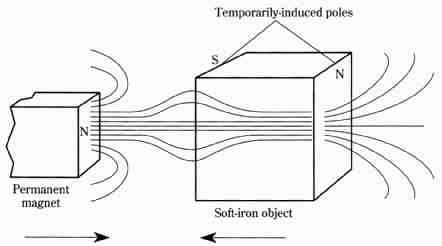AMAZON multi-meters discounts AMAZON oscilloscope discounts
.The basic requisite for motor action is the interaction of forces, which can project their influence through a space. The way in which such interaction is brought about gives rise to the many different kinds of practical motors. There is yet at least one other kind of interaction of magnetic fields that assumes importance in the design of actual motors.
Suppose a child is playing with two bar magnets; if perceptive, the child might observe the possibilities of both attraction and repulsion, and might even notice the consistency with which these effects can be demonstrated. Having attained this degree of awareness, only a small step would be needed to make another intellectual advance; the child might notice the somewhat different behavior between one bar magnet and various soft-iron objects. Such objects, like the other bar magnet, are moved, but always towards the influencing magnet, never away from it.
No permanent magnetic-poles are induced in the soft-iron objects. The temporary magnetic poles of these objects always favor attraction. This is best explained by the concept of reluctance, in which the formation of temporary poles in soft iron is but the secondary result of another phenomenon.
Magnetic “lines” of force tend to form closed loops. By nature, these magnetic force-fields seek the easiest available paths in the closure of these loops. Soft iron affords easier passage than does air. Soft iron allows denser packing of the lines than does air. It is this increased flux density in the iron that accords it preferential treatment by the field. Because the field attempts to maximize this preferential treatment, the soft-iron object experiences a physical force directed to the region of highest flux density in the field—that is to the closest pole of the magnet. But the soft-iron object doesn’t care whether this is a north or south pole. This situation is illustrated in the drawing of FIG. 22.

FIG. 22 The reluctance principle in a simple force-at-a-distance situation.
The permanent magnet and the soft-iron object tend to close the gap between
them. Physical movement occurs so as to minimize the reluctance in the path
of the magnetic lines of forces. This is tantamount to maximizing the flux
density in the soft-iron object. Temporarily-induced poles; Soft-iron object
The term “reluctance” in the magnetic circuit is analogous to “resistance” in the electrical circuit if the terms are defined with care. Low reluctance in a magnetic material allows high flux density with minimal magneto-motive force. Low resistance in the electric circuit allows high charge density with minimal electromotive force. A little contemplation shows that electric motors can have three types of rotors as follows: current carrying coils, permanent magnet, and soft-iron rotors. More than one type can be present in order to secure special effects, such as starting torque or oscillation damping.